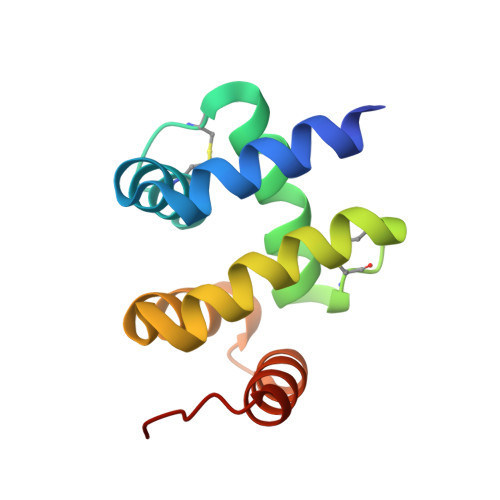X-ray structure and ligand binding study of a moth chemosensory protein
Lartigue, A., Campanacci, V., Roussel, A., Larsson, A.M., Jones, T.A., Tegoni, M., Cambillau, C.(2002) J Biol Chem 277: 32094-32098
- PubMed: 12068017
- DOI: https://doi.org/10.1074/jbc.M204371200
- Primary Citation of Related Structures:
1KX8, 1KX9 - PubMed Abstract:
Chemosensory proteins (CSPs) are believed to be involved in chemical communication and perception. Such proteins, of M(r) 13,000, have been isolated from several sensory organs of a wide range of insect species. Several CSPs have been identified in the antennae and proboscis of the moth Mamestra brassicae. One of them, CSPMbraA6, a 112-amino acid antennal protein, has been expressed in large quantities and is soluble in the Escherichia coli periplasm. X-ray structure determination has been performed in parallel with ligand binding assays using tryptophan fluorescence quenching. The protein has overall dimensions of 25 x 30 x 32 A and exhibits a novel type of alpha-helical fold with six helices connected by alpha-alpha loops. A narrow channel extends within the protein hydrophobic core. Fluorescence quenching with brominated alkyl alcohols or fatty acids and modeling studies indicates that CSPMbraA6 is able to bind such compounds with C12-18 alkyl chains. These ubiquitous proteins might have the role of extracting hydrophobic linear compounds (pheromones, odors, or fatty acids) dispersed in the phospholipid membrane and transporting them to their receptor.
Organizational Affiliation:
Architecture et Fonction des Macromolécules Biologiques, UMR 6098, CNRS and Universités d'Aix-Marseille I and II, 31 chemin J. Aiguier, 13402 Marseille Cedex 20, France.















